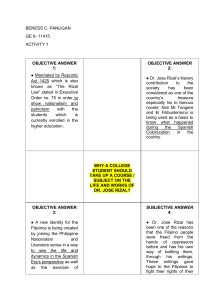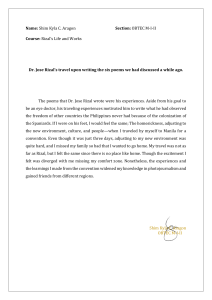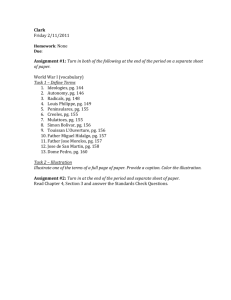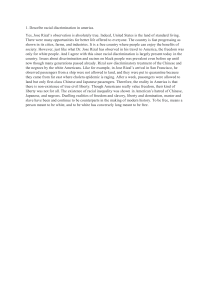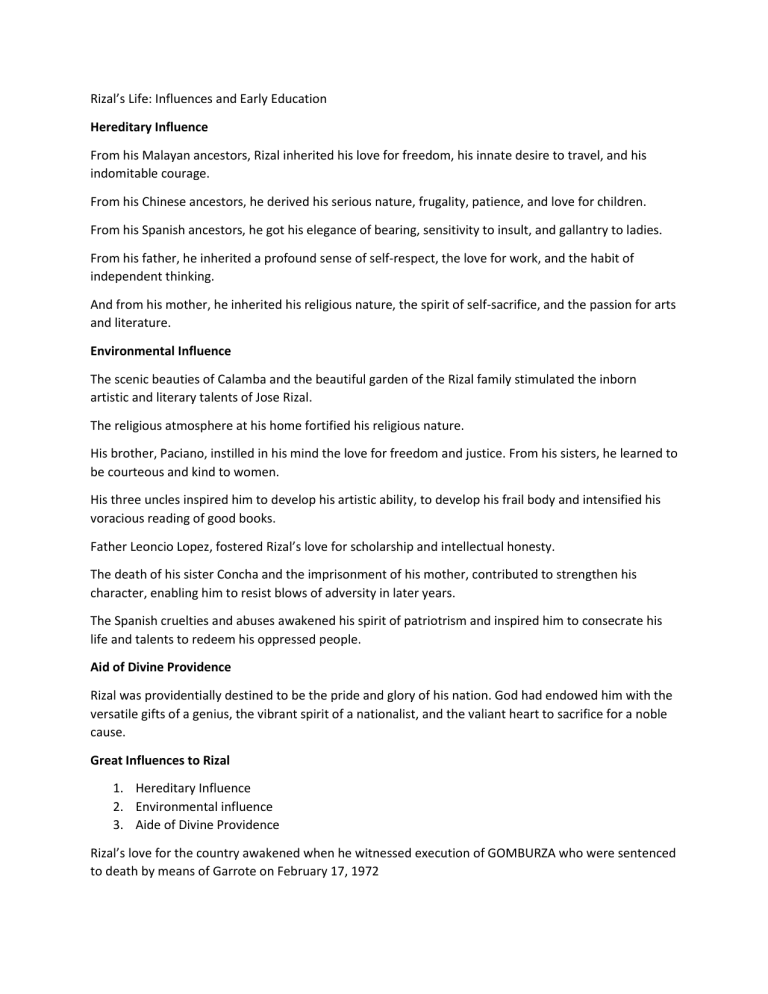
Rizal’s Life: Influences and Early Education Hereditary Influence From his Malayan ancestors, Rizal inherited his love for freedom, his innate desire to travel, and his indomitable courage. From his Chinese ancestors, he derived his serious nature, frugality, patience, and love for children. From his Spanish ancestors, he got his elegance of bearing, sensitivity to insult, and gallantry to ladies. From his father, he inherited a profound sense of self-respect, the love for work, and the habit of independent thinking. And from his mother, he inherited his religious nature, the spirit of self-sacrifice, and the passion for arts and literature. Environmental Influence The scenic beauties of Calamba and the beautiful garden of the Rizal family stimulated the inborn artistic and literary talents of Jose Rizal. The religious atmosphere at his home fortified his religious nature. His brother, Paciano, instilled in his mind the love for freedom and justice. From his sisters, he learned to be courteous and kind to women. His three uncles inspired him to develop his artistic ability, to develop his frail body and intensified his voracious reading of good books. Father Leoncio Lopez, fostered Rizal’s love for scholarship and intellectual honesty. The death of his sister Concha and the imprisonment of his mother, contributed to strengthen his character, enabling him to resist blows of adversity in later years. The Spanish cruelties and abuses awakened his spirit of patriotrism and inspired him to consecrate his life and talents to redeem his oppressed people. Aid of Divine Providence Rizal was providentially destined to be the pride and glory of his nation. God had endowed him with the versatile gifts of a genius, the vibrant spirit of a nationalist, and the valiant heart to sacrifice for a noble cause. Great Influences to Rizal 1. Hereditary Influence 2. Environmental influence 3. Aide of Divine Providence Rizal’s love for the country awakened when he witnessed execution of GOMBURZA who were sentenced to death by means of Garrote on February 17, 1972 Rizal had his early education in Calamba and Biñan. characterized by the four R’s- reading, writing, arithmetic, and religion. Instruction was rigid and strict. Knowledge was forced into the minds of the pupils by means of the tedious memory method aided by the teacher’s whip. It may be said that Rizal, who was born a physical weakling, rose to become an intellect- tual giant not because of, but rather in spite of, the outmoded and back- ward system of instruction obtaining in the Philippines during the last decades of Spanish regime. HERO’S FIRST TEACHER The first teacher of Rizal was his mother, who was a remarkable woman of good character and fine culture. As tutor, Doña Teodora was patient, conscientious, and understanding. It was she who first discovered that her son had a talent for poetry. Accordingly, she encouraged him to write poems. To lighten the monotony of memorizing the ABC’s and to stimulate her son’s imagination, she related many stories. As Jose grew older, his parents employed private tutors to give him lessons at home. The first was Maestro Celestino and the second, Maestro Lucas Padua. Later, an old man named Leon Monroy, a former classmate of Rizal’s father, became the boy’s tutor. This old teacher lived at the Rizal home and instructed Jose in Spanish and Latin. Unfortunately, he did not lived long. He died five months later. After a Monroy’s death, the hero’s parents decided to send their gifted son to a private school in Biñan. Jose Goes to Biñan One Sunday afternoon in June 1869, Jose, after kissing the hands of his parents and a tearful parting from his sister, left Calamba for Biñan. He was accompanied by Paciano, who acted as his second father. The two brothers rode in a carromata, reaching their destination after one and onehalf hours’ drive. They proceeded to their aunt’s house, where Jose was to lodge. It was almost night when they arrived, and the moon was about to rise. First Day in Biñan School The next morning (Monday) Paciano brought his younger brother to the school of Maestro Justiniano Aquino Cruz. The school was in the house of the teacher, which was a small nipa hut about 30 meters from the home of Jose’s aunt. Immediately, Jose was assigned his seat in the class. The teacher asked him: "Do you know Spanish?" "A little, sir," replied the Calamba lad. "Do you know Latin?" "A little, sir." The boys in the class, especially Pedro, the teacher’s son laughed at Jose’s answers. The teacher sharply stopped all noises and begun the lessons of the day. Jose described his teacher in Biñan as follows: "He was tall, thin, long-necked, with sharp nose and a body slightly bent forward, and he used to wear a sinamay shirt, woven by the skilled hands of the women of Batangas. He knew by the heart the grammars by Nebrija and Gainza. Add to this severity that in my judgement was exaggerated and you have a picture, perhaps vague, that I have made of him, but I remember only this." First School Brawl In the afternoon of his first day in school, when the teacher was having his siesta, Jose met the bully, Pedro. He was angry at this bully for making fun of him during his conversation with the teacher in the morning. Jose challenged Pedro to a fight. The latter readily accepted, thinking that he could easily beat the Calamba boy who was smaller and younger. The two boys wrestled furiously in the classroom, much to the glee of their classmates. Jose, having learned the art of wrestling from his athletic Tio Manuel, defeated the bigger boy. For this feat, he became popular among his classmates. After the class in the afternoon, a classmate named Andres Salandanan challenged him to an arm-wrestling match. They went to a sidewalk of a house and wrestled with their arms. Jose, having the weaker arm, lost and nearly cracked his head on the sidewalk. In succeeding days, he had other fights with the boys of Biñan. He was not quarrelsome by nature, but he never ran away from a fight. Jose’s daily routine in Binan Hears mass at 4 a.m. or studies lesson before going to mass Goes to orchard to look for mabolo to eat Breakfast Goes to class at 10 a.m. Lunch break Goes back to school at 2 p.m. Goes home at 5 p.m. Prays with cousins Studies lessons, then draws a little Has supper Prays again Plays in the street if moon is bright Sleeps Best Student in School In academic studies, Jose beat all Biñan boys. He surpassed them all in Spanish, Latin, and other subjects. Some of his older classmates were jealous of his intellectual superiority. They wickedly squealed to the teacher whenever Jose had a fight outside the school, and even told lies to discredit him before the teacher’s eyes. Consequently, the teacher had to punish Jose. End of Biñan Schooling December 17, 1870 – Jose left Biñan Talim – the steamer that Jose rode Arturo Camps – a Frenchman and a friend of Don Francisco, he took care of Jose during the trip Chapter 3 EARLY EDUCATION IN CALAMBA AND BIÑAN Teaching was characterized by four R’s: Reading Writing Arithmetic Religion Instruction was rigid and strict. Knowledge was forced into the minds of pupil. By means of tedious memory method aided by teachers whips. Education in Spanish era: Primary level to the tertiary level of education Schools focused on the Christian Doctrines Separate school for boys and girls Wealthy Filipino or the Ilustrados were accommodated in the schools The Hero’s First Teacher The first teacher of Rizal was her mother A remarkable woman of good character and fine culture Rizal at the age of 3 learned the alphabet and prayers. Doña Teodora discovered Jose’s talent for poetry and encourage him to write Private tutors of Rizal Maestro Celestino was Jose’s first private tutor. Maestro Lucas Padua was second private tutor Maestro Leon Monroy became the hero’s tutor in Spanish and Latin. he was the classmate of Don Francisco (died 5 months later) Uncle Jose Alberto – gave wise direction in the studies of Jose Uncle Gregorio – instilled into the mind of Jose the love for education. “Work hard and perform every task very carefully; learn to be swift as well as thorough; be independent is thinking; and make visual pictures of everything.” Tio Manuel Alberto- seeing Jose was frail in nature, concerned himself with the physical development of his nephew He also taught Jose to love for open air and admiration for the beauty of nature. Jose’s parents decided to send him to a private school in Biñan Jose Goes to Biñan June 1869 – Jose goes to Biñan with Paciano Carromata – transportation Lodged at her aunt’s house First day in Biñan school School of Maestro Justiniano Aquino Cruz – formal teacher Rizal Described his Maestro as tall, thin, long necked, sharp-nosed, with a body slightly bent forward. The school was in maestro’s house First school Brawl Pedro (teacher’s son) (bully) – wrestling Andres Saladan- arm wrestling Jose never run away from a fight Painting lessons in Biñan Near the school was the house of an old painter, Father in-law of the schoolteacher Old Juancho Freely gave Jose painting lessons Jose Rizal and his classmate Jose Guevarra become apprentices of old Jauncho. Daily life in Biñan Jose’s Daily Routine: Hears mass at 4 a.m. or studies lesson before going to mass Goes to orchard to look for a mabolo to eat Breakfast Goes to class at 10a.m Lunch break Goes back to school at 2p.m Goes home at 5p.m Studies lesson and draws a little Has supper Prays again Plays in the street if moon is bright Sleeps Best Student in School Jose surpassed his classmates in Spanish, Latin and other subjects His older classmates were jealous and squealed to the teacher whenever he had fights Jose usually receives five to six blows. End of Biñan Schooling December 17, 1870 Jose left Biñan after one year and a half schooling in that town. Jose receives letter from Saturnina Talim- the steamer that Jose rode Arturo Camps- Frenchman and a friend of Don Francisco, took care of Jose during the trip. Martyrdom of Gom-Bur-Za January 20, 1872- Cavite mutiny February 17, 1872- Fathers Mariano Gomez, Jose Burgos, and Jacinto Zamora were implicated and executed Leaders of Secular movement. To filipinize the Philippine parishes Martyrdom of Gom-Bur-Za Martyrdom of Gom-Bur-Za They inspired Rizal to fight the evils of Spanish tyranny Later in 1891, Rizal dedicated his second novel elfilibusterismo, to GomBurZa. Injustice to Hero’s Mother In 1872, Doña Teodora was arrested on malicious charge that she aided his brother Jose Alberto in trying to poison his wife Jose Alberto planned to divorce his wife because of her infidelity Jose Alberto’s wife connived with the Spanish lieutenant of guardia civil and filed a case against Rizal’s mother Injustice to Hero’s Mother Antonio Vivencio del Rosario-Gobernadorcillio of Calamba, helped the lieutenant arrest Doña Teodora 50 kilometers -Doña Teodora was made to walk from Calamba to the provincial prison in Santa Cruz Great Influences to Rizal (3-8) DARLENE Hero’s first teacher and private tutors (15-19) Christy Painting lesson and daily life in Binan (23-25) Best student in school, End of Binan Schooling (26-29) Injustice to Hero’s Mother (33-34)

